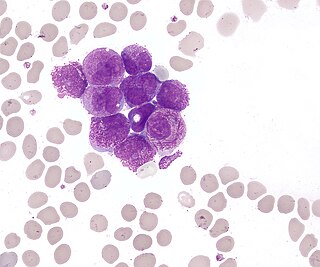
Back لوكيميا حادة بخلايا النخاع الخديج Arabic Promyelozytenleukämie German Leucemia promielocítica aguda Spanish Leucémie aiguë promyélocytaire French לוקמיה פרומיאלוציטית חריפה HE Akutna promijelocitna leukemija Croatian Leucemia promielocitica acuta Italian Acute promyelocytenleukemie Dutch Ostra białaczka promielocytowa Polish Leucemia promielocítica aguda Portuguese
This article needs to be updated. (May 2015) |
| Acute promyelocytic leukemia | |
|---|---|
 | |
| Bone marrow smear from a patient with acute promyelocytic leukemia, showing characteristic abnormal promyelocytes.[1] | |
| Specialty | Hematology and oncology |
| Usual onset | ~40 years old[2] |
| Causes | Uncontrolled proliferation of promyelocytes[2] |
| Frequency | Develops in about 600 to 800 people per year (United States)[2] |
Acute promyelocytic leukemia (APML, APL) is a subtype of acute myeloid leukemia (AML), a cancer of the white blood cells.[3] In APL, there is an abnormal accumulation of immature granulocytes called promyelocytes. The disease is characterized by a chromosomal translocation involving the retinoic acid receptor alpha (RARA) gene and is distinguished from other forms of AML by its responsiveness to all-trans retinoic acid (ATRA; also known as tretinoin) therapy. Acute promyelocytic leukemia was first characterized in 1957[4][5] by French and Norwegian physicians as a hyperacute fatal illness,[3] with a median survival time of less than a week.[6] Today, prognoses have drastically improved; 10-year survival rates are estimated to be approximately 80-90% according to one study.[7][6][8]
- ^ Image by Mikael Häggström, MD. Reference for findings: Syed Zaidi, M.D. "APL with PML-RARA". APL with PML-RARA. Last author update: 1 February 2013
Source image: File:Faggot cell in AML-M3.jpg from PEIR Digital Library (Pathology image database) Archived 2009-03-01 at the Wayback Machine (Public Domain) - ^ a b c "Acute Promyelocytic Leukemia". National Organization for Rare Disorders. Retrieved March 9, 2023.
- ^ a b Cite error: The named reference
MSRwas invoked but never defined (see the help page). - ^ Tallman MS, Altman JK (2008). "Curative strategies in acute promyelocytic leukemia". Hematology Am Soc Hematol Educ Program. 2008: 391–9. doi:10.1182/asheducation-2008.1.391. PMID 19074116.
- ^ Hillestad, LK (November 1957). "Acute promyelocytic leukemia". Acta Med Scand. 159 (3): 189–94. doi:10.1111/j.0954-6820.1957.tb00124.x. PMID 13508085.
- ^ a b Coombs, C. C.; Tavakkoli, M.; Tallman, M. S. (2015-04-17). "Acute promyelocytic leukemia: where did we start, where are we now, and the future". Blood Cancer Journal. 5 (4): e304. doi:10.1038/bcj.2015.25. PMC 4450325. PMID 25885425.
- ^ Cite error: The named reference
Blood2010was invoked but never defined (see the help page). - ^ C C, Coombs (17 April 2015). "Acute promyelocytic leukemia: where did we start, where are we now, and the future". Blood Cancer Journal. 5 (4): 304. doi:10.1038/bcj.2015.25. PMC 4450325. PMID 25885425.